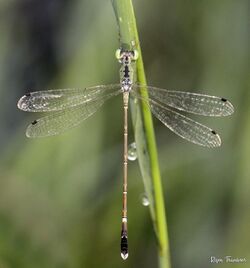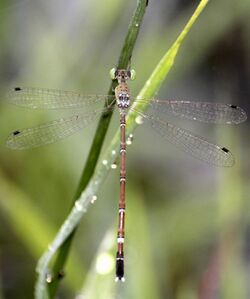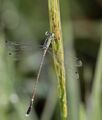Biology:Platylestes kirani
| Platylestes kirani | |
|---|---|

| |
| Male | |

| |
| Female | |
| Scientific classification | |
| Domain: | Eukaryota |
| Kingdom: | Animalia |
| Phylum: | Arthropoda |
| Class: | Insecta |
| Order: | Odonata |
| Suborder: | Zygoptera |
| Family: | Lestidae |
| Genus: | Platylestes |
| Species: | P. kirani
|
| Binomial name | |
| Platylestes kirani Emiliyamma, Palot & Charesh, 2020
| |
Platylestes kirani is a damselfly species in the family Lestidae.[1] This species is known from coastal wetlands in Kerala, South India. The species is named after the late C.G. Kiran, in recognition of his outstanding contribution to the odonate studies in Kerala.[2]
Description and habitat
It is a small dull colored damselfly with apple green eyes. Its prothorax and thorax are in yellowish green color, paler at the sides. There is a broad black stripe on the dorsum of the thorax, straight on the inner border, outwardly expanded at the upper, middle and at the lower end, as in Lestes praemorsus. There are a large number of black spots on the thorax. Its wings are transparent with short and broad pterostigma having white or creamy yellow inner and outer ends. Its abdomen is in olivaceous to warm reddish brown in color with black apical rings on each segments. Anal appendages are whitish with the superiors black at base, curling in at apices to meet each other. Inferior appendages are about half the length of superiors and ends at the middle of sharp spine of inner membrane like expansion of superiors, slender throughout its length, convergent and meet at extreme apices.[2]
Female closely resembles the male in most respects, differing mainly in sexual characters, as in Platylestes platystylus.[2]
This species can be easily distinguished from P. platystylus which also common in Kerala[3] by its broad black band on synthorax.[2][4][5]
This species is mainly found foraging inside the shoreline vegetation and occasionally resting on the stems or on the leaf blades of grasses and sedge.[2]
Terminal abdominal appendages of male
See also
- List of odonates of India
- List of odonata of Kerala
References
- ↑ "World Odonata List". University of Puget Sound. https://www.pugetsound.edu/academics/academic-resources/slater-museum/biodiversity-resources/dragonflies/world-odonata-list2/.
- ↑ 2.0 2.1 2.2 2.3 2.4 Emiliyamma, K.G.; Palot, M. J.; Charesh, C (2020). "A new species of Platylestes Selys (Odonata: Zygoptera: Lestidae) from the coastal area of Kannur District, Kerala, India". Journal of Threatened Taxa 12 (13): 16854–16860. doi:10.11609/jott.5209.12.13.16854-16860. https://threatenedtaxa.org/index.php/JoTT/article/view/5209. Retrieved 2020-09-27.
 This article contains quotations from this source, which is available under the Creative Commons Attribution 4.0 International (CC BY 4.0) license.
This article contains quotations from this source, which is available under the Creative Commons Attribution 4.0 International (CC BY 4.0) license.
- ↑ K.J. Rison; A. Vivek Chandran (2020). "Observations of the damselfly Platylestes cf. platystylus Rambur, 1842 (Insecta: Odonata: Zygoptera: Lestidae) from peninsular India". Journal of Threatened Taxa 12 (10): 16392–16395. doi:10.11609/jott.5834.12.10.16392-16395. https://threatenedtaxa.org/index.php/JoTT/article/view/5834. Retrieved 2020-09-27.
- ↑ C FC Lt. Fraser (1933). The Fauna of British India, including Ceylon and Burma, Odonata Vol. I. Red Lion Court, Fleet Street, London: Taylor and Francis. pp. 59–61. https://archive.org/details/FraserOdonata1.
- ↑ Jules Pierre Rambur (1842) Histoire naturelle des insectes. Névroptères. Paris. Roret. page: 254 (through HathiTrust)
External links
Wikidata ☰ Q99659042 entry
 |





